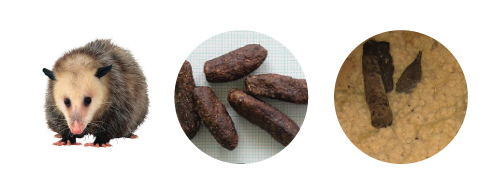

Raccoons are the primary host of Baylisascaris procyonis, a roundworm that can be harmful to people. Roundworm eggs are passed in the feces of infected raccoons, and people become infected by ingesting eggs.
Fecal matter produced by raccoons is tube-shaped, about 2-3 inches long, runs slightly smaller than the diameter of a hot dog. In general, adult raccoon feces closely resemble dog feces.

If a squirrel feels trapped and starts to panic then it may well spray urine and fecal matter over its surroundings. If you have discovered droppings inside your home, attic or basement contact Wildlife Specialist Today!
There are small differences between rat feces and squirrel feces. The most prominent distinction is the two ends. A rat will have more tapered ends of poop while the ends of the squirrel poop are more rounded.

Skunks are nocturnal creatures and rarely venture out during the day. Finding secondary clues of their presence is typically the best way to identify a skunk infestation.
Skunk feces typically measures around 1/2 an inch in diameter and between 1 and 2 inches in length. Often compared to cat feces, skunk droppings can take on slightly different colors and shapes.

Opossum feces are roughly one to two inches in length, smooth on the sides, and may have white or yellowish mold growing on the outer casings. Otherwise, opossum droppings are brown in color.
Like most animal scat, opossum dung often contains bacteria such as Salmonella and leptospirosis. Opossums are also known to carry the highly infectious Equine Protozoal Myoleoncephalitis (EPM), which attacks the nervous system of horses.

Bat droppings, known as guano, are small and dark in coloration. The elongated pellets are crumbly and turn to dust when touched.
Deposits of guano accumulate within walls and attics as well as on the ground and roof tiles. The musty, acrid smell of bat droppings, along with the stains they leave on walls or ceilings, is a sure sign of bat infestations. Due to the hazardous nature of the droppings, property owners should never attempt to remove bat infestations or clean guano deposits on their own.

They usually measure less than 1/4 of an inch in length and are found in areas near food, like kitchen cabinets and drawers, as well as along pathways the rodents consistently travel, such as alongside walls and under the cover of furniture.
Proper sanitation is essential wherever mouse feces is found. The droppings can transmit a variety of diseases including hantavirus, salmonella, and lymphocytic chorio-meningitis (LCM). Contact Gotcha Wildlife Specialists!

Rat droppings look different depending on the species, but they are generally 1/2 to 3/4 of an inch in length.
In order to properly clean up contaminated areas, Wildlife Specialists are the Go-To as they know to use gloves and protective masks to avoid breathing in particles of rat droppings and dried aerosolized urine.